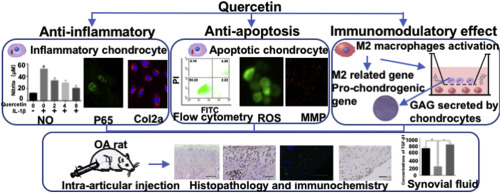当前位置:
X-MOL 学术
›
Free Radical Bio. Med.
›
论文详情
Our official English website, www.x-mol.net, welcomes your
feedback! (Note: you will need to create a separate account there.)
Quercetin alleviates rat osteoarthritis by inhibiting inflammation and apoptosis of chondrocytes, modulating synovial macrophages polarization to M2 macrophages.
Free Radical Biology and Medicine ( IF 7.1 ) Pub Date : 2019-09-21 , DOI: 10.1016/j.freeradbiomed.2019.09.024
Yue Hu 1 , Zhipeng Gui 2 , Yuning Zhou 1 , Lunguo Xia 3 , Kaili Lin 2 , Yuanjin Xu 1
Free Radical Biology and Medicine ( IF 7.1 ) Pub Date : 2019-09-21 , DOI: 10.1016/j.freeradbiomed.2019.09.024
Yue Hu 1 , Zhipeng Gui 2 , Yuning Zhou 1 , Lunguo Xia 3 , Kaili Lin 2 , Yuanjin Xu 1
Affiliation

|
Osteoarthritis (OA) is a progressive joint disorder that is primarily characterized by the degeneration and destruction of the articular cartilage. Cartilage matrix degradation, production of proinflammatory mediators, chondrocyte apoptosis and activation of macrophages in the synovial are involved in OA pathogenesis. Current non-surgical therapies for OA mainly aim at relieving pain but can barely alleviate the progression of OA. Quercetin, a naturally occurring flavonoid has shown potent anti-inflammatory effects, however, its effects and underlying mechanisms on OA have seldom been systematically illuminated. In this study, we explored the protective effects of quercetin on repairing OA-induced cartilage injuries and its possible mechanisms. In vitro, quercetin remarkably suppressed the expression of matrix degrading proteases and inflammatory mediators, meantime promoted the production of cartilage anabolic factors in interleukin-1β-induced (IL-1β) rat chondrocytes. In addition, quercetin exhibited anti-apoptotic effects by decreasing intracellular reactive oxygen species (ROS), restoring mitochondrial membrane potential (MMP) and inhibiting the Caspase-3 pathway in apoptotic rat chondrocytes. Moreover, quercetin induced M2 polarization of macrophages and upregulated the expression of transforming growth factor β (TGF-β) and insulin-like growth factor (IGF), which in turn created a pro-chondrogenic microenvironment for chondrocytes and promoted the synthesis of glycosaminoglycan (GAG) in chondrocytes. In vivo, intra-articular injection of quercetin alleviated the degradation of the cartilage and the apoptosis of chondrocytes in a rat OA model. Moreover, the expression of TGF-β1 and TGF-β2 in the synovial fluid and the ratio of M2 macrophages in the synovial membrane were elevated. In summary, our study proves that quercetin exerts chondroprotective effects by inhibiting inflammation and apoptosis of chondrocytes, modulating synovial macrophages polarization to M2 macrophages and creating a pro-chondrogenic environment for chondrocytes to enhance cartilage repair under OA environment. It is suggested that quercetin may serve as a potential drug for OA treatment.
中文翻译:

槲皮素通过抑制软骨细胞的炎症和细胞凋亡,将滑膜巨噬细胞极化调节为M2巨噬细胞来减轻大鼠骨关节炎。
骨关节炎(OA)是一种进行性关节疾病,其主要特征是关节软骨的变性和破坏。软骨的降解,促炎介质的产生,软骨细胞的凋亡以及滑膜中巨噬细胞的活化都与OA的发病机制有关。当前用于OA的非手术疗法主要旨在减轻疼痛,但是几乎不能缓解OA的进展。槲皮素是一种天然存在的类黄酮,已显示出有效的抗炎作用,但是,其对OA的作用和潜在机制很少得到系统地阐明。在这项研究中,我们探讨了槲皮素对OA诱导的软骨损伤修复的保护作用及其可能的机制。体外,槲皮素显着抑制基质降解蛋白酶和炎性介质的表达,同时促进白介素1β诱导的(IL-1β)大鼠软骨细胞中软骨合成代谢因子的产生。此外,槲皮素通过减少细胞内活性氧(ROS),恢复线粒体膜电位(MMP)和抑制凋亡大鼠软骨细胞中的Caspase-3途径,表现出抗凋亡作用。此外,槲皮素诱导巨噬细胞M2极化并上调转化生长因子β(TGF-β)和胰岛素样生长因子(IGF)的表达,从而为软骨细胞创造了促软骨微环境,并促进了糖胺聚糖的合成(软骨细胞中的GAG)。体内,槲皮素的关节内注射减轻了大鼠OA模型中软骨的降解和软骨细胞的凋亡。此外,滑膜液中TGF-β1和TGF-β2的表达以及滑膜中M2巨噬细胞的比例升高。总而言之,我们的研究证明槲皮素通过抑制软骨细胞的炎症和凋亡,调节滑膜巨噬细胞向M2巨噬细胞的极化,并为软骨细胞提供促软骨形成的环境来增强软骨在OA环境下的软骨修复,从而发挥软骨保护作用。提示槲皮素可以作为OA治疗的潜在药物。总而言之,我们的研究证明槲皮素通过抑制软骨细胞的炎症和凋亡,调节滑膜巨噬细胞向M2巨噬细胞的极化并为软骨细胞创造促软骨形成环境以增强OA环境下的软骨修复发挥软骨保护作用。提示槲皮素可以作为OA治疗的潜在药物。总而言之,我们的研究证明槲皮素通过抑制软骨细胞的炎症和凋亡,调节滑膜巨噬细胞向M2巨噬细胞的极化并为软骨细胞创造促软骨形成环境以增强OA环境下的软骨修复发挥软骨保护作用。建议槲皮素可以作为OA治疗的潜在药物。
更新日期:2019-09-22
中文翻译:

槲皮素通过抑制软骨细胞的炎症和细胞凋亡,将滑膜巨噬细胞极化调节为M2巨噬细胞来减轻大鼠骨关节炎。
骨关节炎(OA)是一种进行性关节疾病,其主要特征是关节软骨的变性和破坏。软骨的降解,促炎介质的产生,软骨细胞的凋亡以及滑膜中巨噬细胞的活化都与OA的发病机制有关。当前用于OA的非手术疗法主要旨在减轻疼痛,但是几乎不能缓解OA的进展。槲皮素是一种天然存在的类黄酮,已显示出有效的抗炎作用,但是,其对OA的作用和潜在机制很少得到系统地阐明。在这项研究中,我们探讨了槲皮素对OA诱导的软骨损伤修复的保护作用及其可能的机制。体外,槲皮素显着抑制基质降解蛋白酶和炎性介质的表达,同时促进白介素1β诱导的(IL-1β)大鼠软骨细胞中软骨合成代谢因子的产生。此外,槲皮素通过减少细胞内活性氧(ROS),恢复线粒体膜电位(MMP)和抑制凋亡大鼠软骨细胞中的Caspase-3途径,表现出抗凋亡作用。此外,槲皮素诱导巨噬细胞M2极化并上调转化生长因子β(TGF-β)和胰岛素样生长因子(IGF)的表达,从而为软骨细胞创造了促软骨微环境,并促进了糖胺聚糖的合成(软骨细胞中的GAG)。体内,槲皮素的关节内注射减轻了大鼠OA模型中软骨的降解和软骨细胞的凋亡。此外,滑膜液中TGF-β1和TGF-β2的表达以及滑膜中M2巨噬细胞的比例升高。总而言之,我们的研究证明槲皮素通过抑制软骨细胞的炎症和凋亡,调节滑膜巨噬细胞向M2巨噬细胞的极化,并为软骨细胞提供促软骨形成的环境来增强软骨在OA环境下的软骨修复,从而发挥软骨保护作用。提示槲皮素可以作为OA治疗的潜在药物。总而言之,我们的研究证明槲皮素通过抑制软骨细胞的炎症和凋亡,调节滑膜巨噬细胞向M2巨噬细胞的极化并为软骨细胞创造促软骨形成环境以增强OA环境下的软骨修复发挥软骨保护作用。提示槲皮素可以作为OA治疗的潜在药物。总而言之,我们的研究证明槲皮素通过抑制软骨细胞的炎症和凋亡,调节滑膜巨噬细胞向M2巨噬细胞的极化并为软骨细胞创造促软骨形成环境以增强OA环境下的软骨修复发挥软骨保护作用。建议槲皮素可以作为OA治疗的潜在药物。































 京公网安备 11010802027423号
京公网安备 11010802027423号